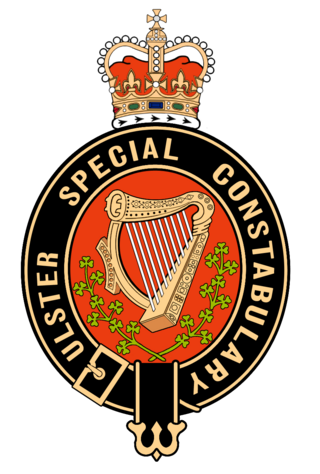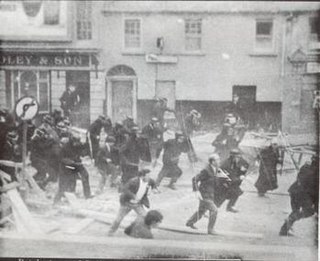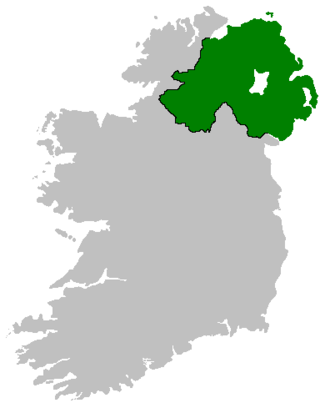Related Research Articles

The Royal Ulster Constabulary (RUC) was the police force in Northern Ireland from 1922 to 2001. It was founded on 1 June 1922 as a successor to the Royal Irish Constabulary (RIC) following the partition of Ireland. At its peak the force had around 8,500 officers, with a further 4,500 who were members of the RUC Reserve.

The Omagh bombing was a car bombing on 15 August 1998 in the town of Omagh in County Tyrone, Northern Ireland. It was carried out by the Real Irish Republican Army, a Provisional Irish Republican Army (IRA) splinter group who opposed the IRA's ceasefire and the Good Friday Agreement, signed earlier in the year. The bombing killed 29 people and injured about 220 others, making it the deadliest single incident of the Troubles in Northern Ireland. Telephoned warnings which did not specify the actual location had been sent almost forty minutes beforehand but police inadvertently moved people toward the bomb.
The Stevens Inquiries were three official British government inquiries led by Sir John Stevens concerning collusion in Northern Ireland between loyalist paramilitaries and the state security forces. While Stevens declared in 1990 that collusion was "neither wide-spread nor institutionalised", by April 2003 he acknowledged that he had uncovered collusion at a level "way beyond" his 1990 view. Much of Stevens' evidence was obtained from advanced fingerprint techniques to link people to documents. By 2005 the team had identified 2,000 people from their prints with a further 1,015 sets of prints outstanding.

The Police Service of Northern Ireland is the police force that serves Northern Ireland. It is the successor to the Royal Ulster Constabulary (RUC) after it was reformed and renamed in 2001 on the recommendation of the Patten Report.

The Ulster Special Constabulary was a quasi-military reserve special constable police force in what would later become Northern Ireland. It was set up in October 1920, shortly before the partition of Ireland. It was an armed corps, organised partially on military lines and called out in times of emergency, such as war or insurgency. It performed this role most notably in the early 1920s during the Irish War of Independence and the 1956-1962 IRA Border Campaign.
The Criminal Investigation Department (CID) is the branch of a police force to which most plainclothes detectives belong in the United Kingdom and many Commonwealth nations. A force's CID is distinct from its Special Branch. The name derives from the CID of the Metropolitan Police, formed on 8 April 1878 by C. E. Howard Vincent as a re-formation of its Detective Branch. British colonial police forces all over the world adopted the terminology developed in the UK in the 19th and early 20th centuries, and later the police forces of those countries often retained it after independence. English-language media often use "CID" as a translation to refer to comparable organisations in other countries.
During the period known as the Troubles in Northern Ireland (1969–1998), the British Army and Royal Ulster Constabulary (RUC) were accused by Republicans of operating a "shoot-to-kill" policy, under which suspected paramilitaries were alleged to have been deliberately killed without any attempt to arrest them. Such a policy was alleged to have been directed almost exclusively at suspected or actual members of Irish republican paramilitary groups. The Special Air Service (SAS) is the most high-profile of the agencies that were accused of employing this policy, as well as other British Army regiments, and the RUC.
Sir Ronald Flanagan is a retired senior Northern Irish police officer. He was the Home Office Chief Inspector of Constabulary for the United Kingdom excluding Scotland. Sir Ronnie was previously the Chief Constable of the Police Service of Northern Ireland (PSNI) since its creation in 2001 to 2002, and had been Chief Constable of its predecessor, the Royal Ulster Constabulary (RUC) until 2001.

The Loughgall ambush took place on 8 May 1987 in the village of Loughgall, County Armagh, Northern Ireland. An eight-man unit of the Provisional Irish Republican Army (IRA) launched an attack on the Royal Ulster Constabulary (RUC) base in the village. An IRA member drove a digger with a bomb in its bucket through the perimeter fence, while the rest of the unit arrived in a van and fired on the building. The bomb exploded and destroyed almost half of the base. Soldiers from the British Army's Special Air Service (SAS) then returned fire both from within the base and from hidden positions around it in a pre-planned ambush, killing all of the attackers. Two of them were subsequently found to have been unarmed when they were killed.
The Northern campaign was a series of attacks by the Irish Republican Army (IRA) Northern Command between September 1942 and December 1944 against the security forces in Northern Ireland. The action taken by the Northern Ireland and the Republic of Ireland governments as a result of these attacks shattered the IRA and resulted in the former being free from IRA activity by the end of World War II.

The Loughinisland massacre took place on 18 June 1994 in the small village of Loughinisland, County Down, Northern Ireland. Members of the Ulster Volunteer Force (UVF), a loyalist paramilitary group, burst into a pub with assault rifles and fired on the customers, killing six civilians and wounding five. The pub was targeted because it was frequented mainly by Catholics, and was crowded with people watching the Republic of Ireland play against Italy in the 1994 FIFA World Cup. It is thus sometimes called the "World Cup massacre". The UVF claimed the attack was retaliation for the killing of three UVF members by the Irish National Liberation Army (INLA).

During 12–16 August 1969, there was an outbreak of political and sectarian violence throughout Northern Ireland, which is often seen as the beginning of the thirty-year conflict known as the Troubles. There had been sporadic violence throughout the year arising out of the Northern Ireland civil rights campaign, which demanded an end to discrimination against Catholics and Irish nationalists. Civil rights marches had been attacked by Protestant loyalists, and protesters often clashed with the Royal Ulster Constabulary (RUC), the overwhelmingly Protestant police force.
Martin McGartland is a former British informer who infiltrated the Provisional Irish Republican Army (IRA) in 1989 to pass information to RUC Special Branch.

The Special Patrol Group (SPG) of the Royal Ulster Constabulary was a tactical reserve of 150 officers which had the role: "to provide backup in civil commotion, to police sensitive areas at times of confrontation, and to show the flag in a disciplined and impressive way to those who wished to break the peace." Formerly known as the Police Reserve Force, the name was changed to Special Patrol Group in 1970 to avoid confusion between the Reserve Force and the newly formed RUC Reserve.
The Reavey and O'Dowd killings were two co-ordinated gun attacks on 4 January 1976 in County Armagh, Northern Ireland. Six Catholic civilians died after members of the Ulster Volunteer Force (UVF), an Ulster loyalist paramilitary group, broke into their homes and shot them. Three members of the Reavey family were shot at their home in Whitecross and four members of the O'Dowd family were shot at their home in Ballydougan. Two of the Reaveys and three of the O'Dowds were killed outright, with the third Reavey victim dying of brain hemorrhage almost a month later.
Joseph "Joe" Fenton was an estate agent from Belfast, Northern Ireland, killed by the Provisional Irish Republican Army (IRA) for acting as an informer for RUC Special Branch.

James Gamble, KPM, is a former police officer and head of Belfast region for the now disbanded RUC Special Branch.

Shoot to Kill is a four-hour drama documentary reconstruction of the events that led to the 1984–86 Stalker Inquiry into the shooting of six terrorist suspects in Northern Ireland in 1982 by a specialist unit of the Royal Ulster Constabulary (RUC), allegedly without warning ; the organised fabrication of false accounts of the events; and the difficulties created for the inquiry team in their investigation.
John Oliver Weir is an Ulster loyalist born and raised in the Republic of Ireland. He served as an officer in Northern Ireland's Royal Ulster Constabulary's (RUC) Special Patrol Group (SPG), and was a volunteer in the illegal Ulster Volunteer Force (UVF). As a member of the UVF's Mid-Ulster Brigade led by Robin "the Jackal" Jackson, Weir was a part of the Glenanne gang, a group of loyalist extremists that carried out sectarian attacks mainly in the County Armagh area in the mid-1970s.

The Jonesborough ambush took place on 20 March 1989 near the Irish border outside the village of Jonesborough, County Armagh, Northern Ireland. Two senior Royal Ulster Constabulary (RUC) officers, Chief Superintendent Harry Breen and Superintendent Bob Buchanan, were shot dead in an ambush by the Provisional IRA South Armagh Brigade. Breen and Buchanan were returning from an informal cross-border security conference in Dundalk with senior Garda officers when Buchanan's car, a red Vauxhall Cavalier, was flagged down and fired upon by six IRA gunmen, who the policemen had taken for British soldiers. Buchanan was killed outright whilst Breen, suffering gunshot wounds, was shot in the back of the head after he had left the car waving a white handkerchief. They were the highest-ranking RUC officers to be killed during the Troubles.
References
- ↑ RUC Special Branch independent fiefdom did 'as they liked', Irish Times, 14 December 2012
- ↑ Vicky Conway, Policing Twentieth Century Ireland: A History of An Garda Síochána, p. 139